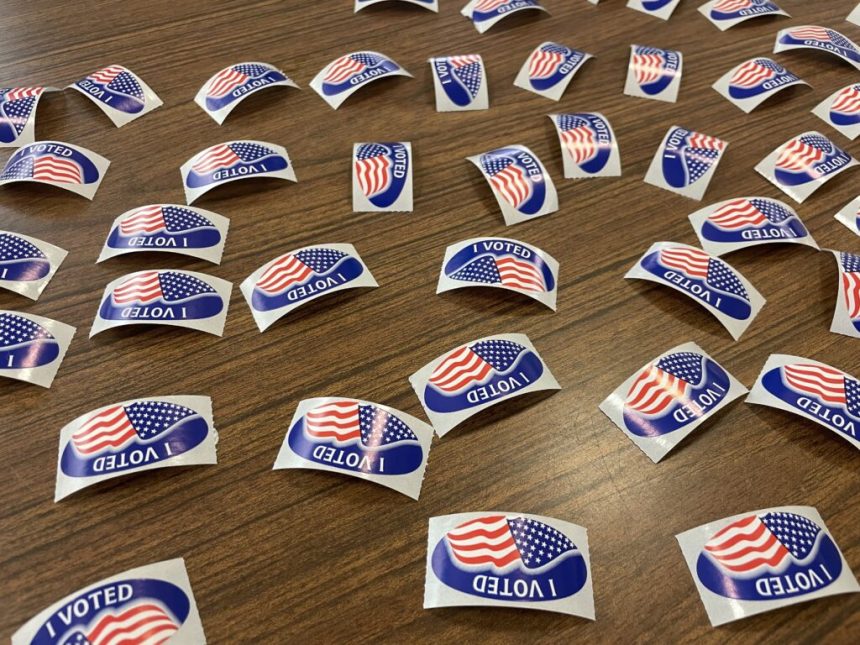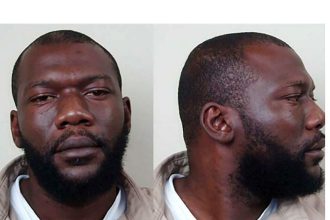“I Voted” stickers are displayed at a Richmond polling place during the 2022 midterm elections. (Photo by Graham Moomaw/Virginia Mercury)
It’s been 20 years since Virginia voters elected a slate of three statewide officials from different parties. The gradual tribalization of state politics has translated into more and more Virginians coming to the polls thinking of themselves as members of team red or team blue.
Four years ago, Republicans swept the three statewide races with nearly identical percentages of the vote (50.6, 50.7 and 50.4) in races for governor, lieutenant governor and attorney general. Furthermore, the nonpartisan Virginia Public Access Project found that 2001 House of Delegates elections were highly correlated with the gubernatorial results.
But recent polls ahead of the state’s pivotal elections on Nov. 4 suggest Virginia could expect a revival of ticket splitting, which used to be more common during the first four decades of competitive two-party statewide elections.
Last week, the Washington Post and VCU released separate polls showing Democrat Abigail Spanberger leading Republican Winsome Earle-Sears in the governor’s race by 12 and seven percentage points, respectively. But the surveys suggested the down ballot races could be tighter, with the VCU poll showing Republican Jason Miyares, the incumbent attorney general, with a slight lead over Democratic challenger Jay Jones. A poll published this week by the Wason Center yielded similar results.
Below is a look – in reverse chronological order – of the dozen split tickets since 1969, which marked the advent of competitive two-party politics in the Old Dominion.
Now-U.S. Sen. Tim Kaine won the governor’s race by nearly 6 percentage points, but his two Democratic running mates both lost tight contests. The split outcome can be explained in part by how the mountain twang of GOP gubernatorial candidate Terry Kilgore failed to resonate with voters beyond the mountains of Southwest Virginia, as the Washington Post reported at the time. In affluent Fairfax County, for example, Kilgore was outperformed by his GOP ticket mates by more than 3 percentage points. Though it took a recount for Republican Bob McDonnell to be declared winner in the attorney general’s race, the GOP won a majority of the three statewide offices.

Democrats today wouldn’t recognize the playbook that Mark Warner followed in his successful bid for governor. Warner, now Virginia’s other U.S. senator, remained silent on abortion and other hot-button issues. He invested considerable time and energy in rural Virginia, where he sponsored a NASCAR team, lined country roads with blaze-orange Sportsmen for Warner signs and hired a bluegrass band. His tack to the right left just enough coattails for Tim Kaine to win a slender majority in a three-way race for lieutenant governor.
Jerry Kilgore, who served as Gov. Allen’s public safety secretary, ran a law-and-order campaign for attorney general that blasted Democrat Donald McEachin for opposing the death penalty and supporting gun control. Warner disavowed those two positions taken by McEachin, the Democrats’ first Black candidate for attorney general. McEachin, whose campaign funds were depleted in a bruising four-way Democratic primary, managed only 39.9% of the vote, an all-time low for a Democratic statewide candidate.

In the spring of 1993, George Allen was 30 percentage points down in the polls, but it turned out he was right where he wanted to be. Allen considered himself an insurgent who would topple the Democratic “elitist oligarchs” that had ruled Virginia for a dozen years. Attorney General Mary Sue Terry had been the Democrats’ top vote-getter in 1985 and 1989, but her cautious personality was ill suited for the role of party standard bearer.
By contrast, Allen threw himself into the hustings with gusto, pulling off an upset that included a Jim Gilmore victory in the race for attorney general. But the GOP fell short of a sweep as Democratic Lt. Gov. Don Beyer Jr. defeated Mike Farris, a homeschooling advocate associated with the Christian right. In the waning days of the campaign, Beyer accused Farris of censorship and book-banning with TV ads that featured characters from the Wizard of Oz. Beyer out-performed Terry by 14 percentage points.

After being locked out of the Executive Mansion for a century, Virginia Republicans won a third straight gubernatorial election in 1977. Lt. Gov. John Dalton won the office that had eluded his father, Ted, who had run twice for governor in the 1950s. Dalton carried eight of the state’s 10 congressional districts, ending his opponent Henry Howell’s decade-long populist crusade.
The 1977 election also marked an assertive debut for Democrat Chuck Robb, the son-in-law of former President Lyndon B. Johnson. By drawing support from some conservatives and business leaders spooked by Howell, Robb brought together a coalition that would lead Democrats out of the wilderness.

Virginia’s continuing political realignment resulted in an epic gubernatorial election that was later memorialized in “The Shad Treatment,” a lightly fictionalized novel by Garrett Epps. The 1973 race featured former Democratic Gov. Mills Godwin running as a Republican and populist Democrat Henry Howell running as an independent. Democrats, who mostly backed Howell, did not nominate a candidate. Howell – who railed against the “big boys” – was opposed by every major newspaper and the collective force of the state’s business community.
Voter turnout topped 1 million for the first time in Virginia history. Howell came within 15,000 votes of defeating Godwin. Democratic Attorney General Andrew Miller won re-election in a landslide, preventing a GOP sweep.

The splintering of the Virginia Democratic Party in the aftermath of the federal Voting Rights Act created an opportunity for Republicans to elect a governor for the first time in a century. In addition to a moderate Democrat, the ballot included three conservative Democrats running under various third-party banners.
Republican Linwood Holton, a Roanoke lawyer, was bolstered by GOP unity and energy from President Richard Nixon’s victory the previous year. Holton attracted disaffected Democrats, both conservative White voters and a healthy share of recently franchised Black ones. Holton carried the core cities of Hampton, Newport News and Richmond, while capturing Alexandria, Arlington County and Fairfax County in the Washington suburbs. Democrats managed to hold the two down-ticket seats. J. Sargeant Reynolds — a young, handsome leader that many considered Virginia’s answer to John F. Kennedy — was sworn in as lieutenant governor in January 1970. Eighteen months later, Reynolds would be dead from an inoperable brain tumor.
SUBSCRIBE: GET THE MORNING HEADLINES DELIVERED TO YOUR INBOX









